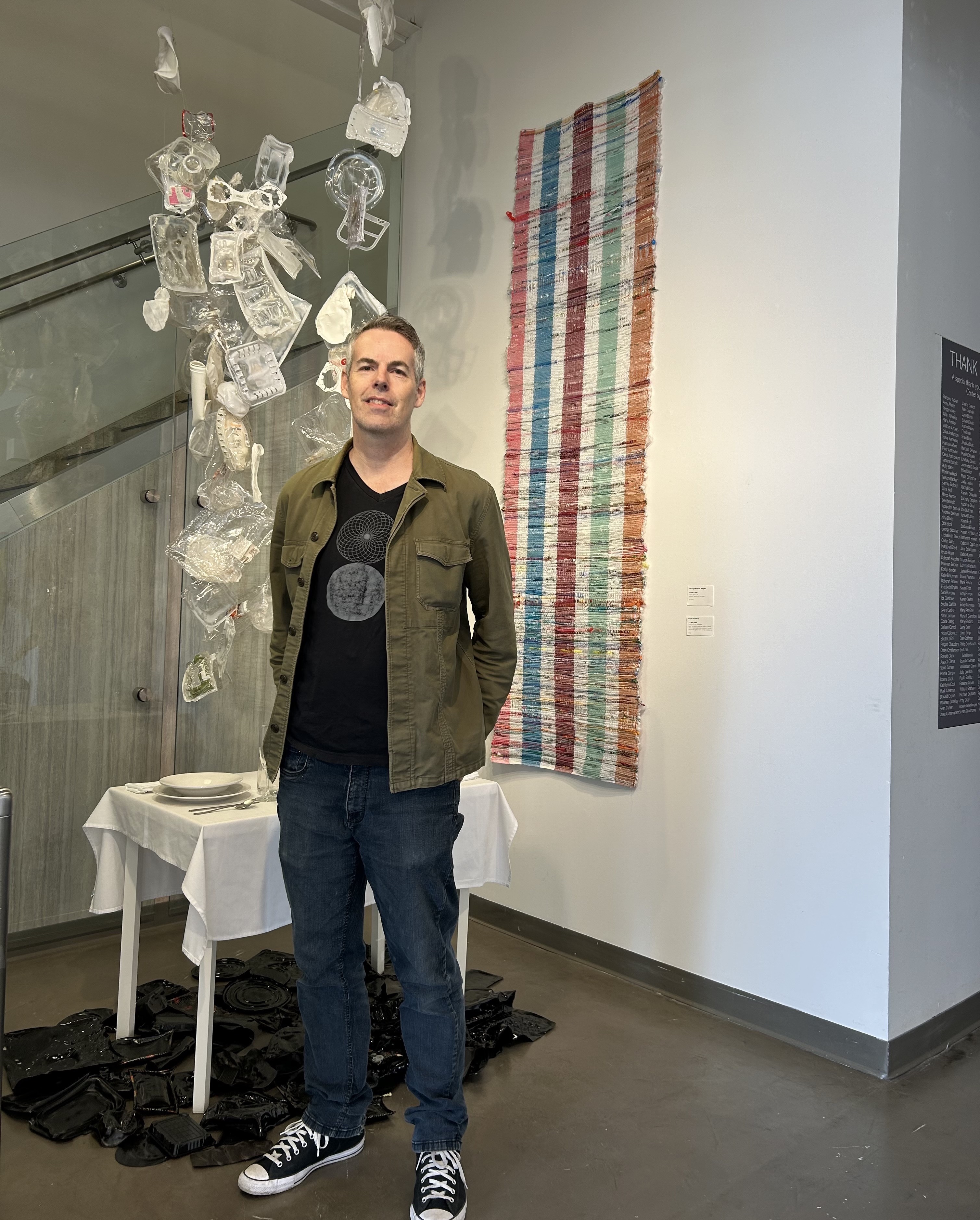
Bryan Northup eyes a one-inch piece of black plastic on the sidewalk. “I need to pick that up,” he says.
The environmental artist and sculptor, who works out of his home in Oak Park, recently combined his new and old pieces made from trash for the exhibit, “You’re Not Really Seeing This,” at the Evanston Art Center. His next exhibition, “Secret Ingredients,” will be at the Ukrainian Institute of Modern Art from May 11 to July 7.
Northup collects plastic waste to construct his abstract installations. His collaborator, environmental artist Kelsey Merreck Wagner, weaves recycled materials like plastic bags and mesh clementine packaging into multi-sized tapestries. Northup wanted his exhibit to force viewers to confront how their everyday waste contributes to the global climate crisis.
No, Northup doesn't clean the plastic he uses in his work. “Dirt and gunk,” and probably even DNA, are part of the piece, he says. In 2015, he discovered his trademark rolling technique when he used trash to create a sculptural replica of a sushi platter for a food-themed exhibition. To craft the layers of faux seaweed, rice and raw fish, Northup cut cross sections of rolled stacks of soft plastic and foam. Until then, he worked primarily with glass.
The self-described hoarder often returns home with bags full of treasure (trash).
“Eventually people are going to realize making plastic was a bad idea,” Northup says. “Maybe they'll stop, and this work that I made is a record of the time we weren't really realizing that yet.”

This interview has been edited and condensed for length and clarity.
Where do you get the materials that you use for your work?
If I wasn't an artist, I would be a hoarder. For the concrete and steel installation, it was a sink in my house that we smashed up. I just couldn't throw it away. I'm in the habit of collecting all the plastic that comes through our house. It goes down to the studio and waits for me to roll it up like sushi. I've been doing this for almost 10 years, people know I do it, and I get little bags left on my front porch, so I'm kind of a garbage man in that way.
Walk me through your creative process.
Color is important to me. People can identify with a color: They either like it or don't, or it draws them in to look deeper. But I also like just rolling plastic. I feel like that process mimics the processes of geology, like the rolling of the crust and the layers of the Earth. I end up with a bunch of components that I then arrange and make something that might be permanent or might be taken apart tomorrow because I don't like how it looks.
What project stands out to you?
After I did the “Sea Inside” exhibit at the International Surgical Museum just before the pandemic, I was like, “OK, if I go in this pandemic, I'm just really happy I did that show.” That was most of my finished pieces and strong work that I was really happy to show together.
I'm sure the single-use masks and gloves from the pandemic bothered you.
I have a wearable piece that I made with surgical masks, and I was walking around, of course, picking those up because people would just throw them on the street. That sounds disgusting — I was wearing gloves when I did that. I laminated them between plastic layers, so you're not going to be touching COVID masks or anything. It's a record of the time.
“Sea Inside” made me a little uncomfortable. You say your abstract installations blur the line between internal organs and appetizing food to depict how society is saturated with plastics at the cellular level. What do you want people to feel when they view this exhibition?
Discomfort. An awakening of, “Oh, this is what we're doing to ourselves, not just the planet. It's a loop that we're part of.” We're so numb to plastic, and it's just one contributor to the climate crisis we're in.
What do you feel when you look at “Sea Inside”?
I am disgusted by it — it's guilt, and environmental despair. But I get a sense of satisfaction that something is being done with this material. This material is thought of as ephemeral. But it's not. It's here for a long, long time. So I think getting that message across to people is critical. I go back to the Banksy quote, “Art should comfort the disturbed and disturb the comfortable.”
What can people expect from “Secret Ingredients,” your upcoming exhibition at the Ukrainian Institute of Modern Art in Chicago?
I’m working with artist Ginny Krueger, and she does a lot of found object work and assemblage. “You're Not Really Seeing This” was more focused, and I'm just going to be taking all these things and putting it into a space, which I am imagining as a big cauldron, and mixing it with Ginny's work. And it's going to be very textural and very colorful.
How has your experience creating art from thrown-away materials changed the way you move through life?
I want to tread as lightly on the planet as I can. I had kids during this whole process of changing my medium. I’m doing it for them, and instilling that care about the planet. My little boy is always picking up plastic and making stuff with it. To the dismay of my family, I just keep collecting. But I'm still plagued by this feeling that it's not enough. I'm always trying to offset it with what I'm making.